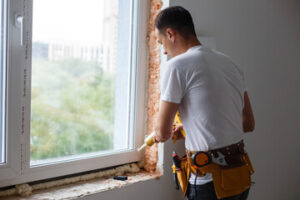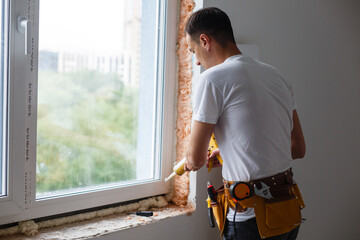If a pane of glass has shattered, the first step is to cover the break with tape. Masking or clear packing tape works well. Duct tape is also an option. This simple fix will prevent more breakage and protect your home from drafts and moisture until a window expert arrives.
 Painting is not only a cosmetic improvement, but it can also help protect the windows from moisture penetration and decay. The paint should be able to cope with the hostile environment of a window and preferably be an oil-based rather than a latex coating. For professional help, contact Window Repair Naperville.
Painting is not only a cosmetic improvement, but it can also help protect the windows from moisture penetration and decay. The paint should be able to cope with the hostile environment of a window and preferably be an oil-based rather than a latex coating. For professional help, contact Window Repair Naperville.
Wood, especially older wood, is porous and requires a protective layer to prevent moisture penetration. Water leaking into joints and muntins, at the meeting of the glass and frame and around fittings is very damaging and will quickly lead to rotting and deterioration of the wood and paintwork. The use of a good quality water-based fungicidal wood preservative is recommended on wooden windows to reduce future problems. This is usually applied with a brush or spray and should be carefully controlled to avoid over-spray. The application of a suitable fungicide should be carried out according to the manufacturer’s recommendations.
Once the wood has been treated the window can be stabilized and repainted. When re-painting wood it is important to allow sufficient time for the paint to dry before re-adhering the sash and closing the window. A linseed oil paint, for example, may take up to six months to cure completely and will need a lot of care in the preparation and application.
If there are areas of the frame and sash where fungi have already penetrated the wood, these should be sanded down to bare timber and primed to improve adhesion. It is often possible to fill deep losses in wood with a special epoxy putty which can be sanded and then painted as normal.
When a window is repaired it should be made as energy-efficient as possible by the installation of appropriate weatherstripping to reduce air infiltration. A variety of products are available for this purpose, either felt strips or rolled vinyl spring strips which can be fastened at the top and bottom edges of the frame and in the meeting rails. These are generally a better option than the old weatherstripping which is prone to breaking down and absorbing moisture. This can result in the windows no longer sealing correctly.
Water Damage
When water damage becomes a problem it’s crucial to take immediate action. If left unattended window water damage can lead to serious structural issues throughout the home. Water damage around windows and doors can also be a sign of a more serious issue, such as a leaky roof or faulty window installation.
The first step in repairing window water damage is identifying the source of the leak and making sure the area is properly sealed and weatherproofed. Next, any visible signs of water damage such as puddles of standing water or discoloration of walls or ceiling around a window should be addressed. It’s also important to keep an eye out for the presence of mold or mildew around windows as these substances thrive in damp environments.
If any wood surrounding a window is showing signs of rot it should be removed and replaced. This may require the use of a saw and a drill. If the rotting is extensive it might be necessary to replace any structural elements that have been affected as well. Once the area is clean and dry it’s a good idea to paint or stain the area, preferably using an exterior-grade paint or stain that is specifically formulated for trim work or exteriors.
Finally, it’s important to make sure that any gaps and cracks are properly caulked and weatherproofed. This will help to keep out water as well as improve energy efficiency by reducing drafts. It’s a good idea to do this regularly, especially after any big weather events like heavy rain or flooding.
When it comes to window repair, professionals are typically the best choice. They have the knowledge, skills, and tools to accurately assess the problem, identify underlying causes, and implement effective repairs. They can also provide recommendations on how to best maintain your windows and prevent future problems. This can help you avoid expensive and time-consuming window repairs in the future.
Muntins & Mullions
When it comes to window design, many homeowners may not know the difference between a muntin and a mullion. These terms sound similar and have a lot in common, but they are not the same thing. Knowing the difference between these two components can be a huge help to you as a homeowner, especially when you are shopping for replacement windows.
Essentially, a mullion is a structural component that holds individual window units within a broader frame. It can be positioned vertically or horizontally and is often adorned with decorative elements like grilles. These elements serve more than a simple aesthetic purpose, as they also carry a great deal of weight and evenly distribute wind loads.
On the other hand, a muntin is a decorative element that separates the lites (or panes) in a window. It can be a single horizontal or vertical bar, or it can comprise several smaller bars that span the entire window. In most cases, these bars are arranged in a grid-like pattern and are often used to give the appearance of mullions, but they do not function as such.
Muntins were initially designed to provide additional support for early windows placed on walls, as they prevented the outer walls from carrying the entire weight of the glass. Today, however, these elements are mostly used to add visual interest to a window or door and are seen as a part of classic home styles like Colonial or Tudor.
Regardless of their origins, muntins and mullions are both important elements in a window and as such should be maintained and repaired when necessary. Fortunately, repairing a broken muntin or mullion is a relatively easy task that can be completed by a professional.
Another key part of a window is the drip cap, which prevents water from entering the house and causes damage. Replacing a rotted or damaged drip cap is a quick and affordable repair that can be completed by a home improvement expert.
Broken Glass
If a window is broken by a bad storm, a kid’s ball, or some other cause, it needs to be repaired right away. Otherwise, shards of glass can wreak havoc on your home’s interior and create a safety hazard for pets or children who might stumble into them. In addition, a broken window can lead to water or air leaks, and even rotting around the frame.
Depending on the type of breakage, window repair can be as simple or as complex as putting in a new pane of glass. A cracked window, especially one that is a large crack, can be difficult to fix, and you should always wear gloves when handling glass. You’ll also need to be careful about the materials you use, as some are toxic if inhaled or ingested.
Professionals are well versed in the correct materials to use and in how to safely remove waste, so no shards remain in your home. They are also familiar with various types of glass and can advise you about what kind of replacement is best for your home. Often, tempered glass is the preferred choice for windows, as it is more durable, less likely to crack, and doesn’t leave dangerous, sharp shards when broken.
Another aspect of window repair that makes a professional more desirable than an inexperienced homeowner is the ability to avoid costly mistakes. For example, the wrong amount of putty could cause the frame to swell, clouding the window or pushing it from the frame, letting drafts into your home. Likewise, incorrectly laying glazier points can break the new pane of glass.
If a crack is not too extensive, you might be able to fix it yourself. However, for larger cracks, it’s best to hire a professional. In addition to avoiding expensive mistakes, professionals know how to properly install a new pane of glass and can make sure that the seal is tight, so drafts are kept out and heat stays in. They can also advise you on the proper type of glass for your home, such as low-emissivity glass to reduce energy loss or laminated glass that controls glare and protects against breakage.

